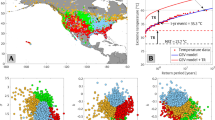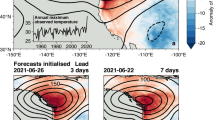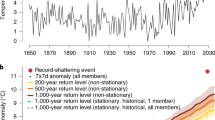Abstract
LAWRENCE'S information on possible factors affecting the temperature record at Eskdalemuir Observatory, which we had unfortunately overlooked, is appreciated. It is, however, difficult to find suitable neighbouring stations, with homogeneous data series in a conveniently available form. With respect to the possible shelterbelt effects, the tendency would be towards higher maxima and lower minima in 1957–67 than in 1925–35. In fact, for anticyclonic type, which should best reflect this influence, the maxima and minima increase or decrease together in all four months investigated.
This is a preview of subscription content, access via your institution
Access options
Subscribe to this journal
Receive 51 print issues and online access
$199.00 per year
only $3.90 per issue
Buy this article
- Purchase on SpringerLink
- Instant access to full article PDF
Prices may be subject to local taxes which are calculated during checkout
Similar content being viewed by others
References
Lamb, H. H., The English Climate, 55 (second ed.) (English Universities Press, London, 1964).
Barry, R. G., Met. Mag., 92, 300 (1963).
Barry, R. G., Liverpool Essays in Geography (edit. by Steel, R. W., and Lawton, R.), 85 (Longmans, London, 1967).
Lamb, H. H., Weather, 18, 194 (1963).
Lamb, H. H., Geog. J., 132 (2), 193 (1966).
Author information
Authors and Affiliations
Rights and permissions
About this article
Cite this article
BARRY, R., PERRY, A. “Weather-type” Frequencies and Temperature Fluctuation: a Reply. Nature 226, 634 (1970). https://doi.org/10.1038/226634a0
Received:
Issue date:
DOI: https://doi.org/10.1038/226634a0



